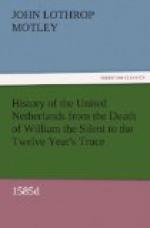The treaty was signed on the 17th August. Antwerp was to return to its obedience. There was to be an entire amnesty and oblivion for the past, without a single exception. Royalist absentees were to be reinstated in their possessions. Monasteries, churches, and the King’s domains were to be restored to their former proprietors. The inhabitants of the city were to practise nothing but the Catholic religion. Those who refused to conform were allowed to remain two years for the purpose of winding up their affairs and selling out their property, provided that during that period they lived “without scandal towards the ancient religion”—a very vague and unsatisfactory condition. All prisoners were to be released excepting Teligny. Four hundred thousand florins were to be paid by the authorities as a fine. The patriot garrison was to leave the city with arms and baggage and all the honours of war.
This capitulation gave more satisfaction to the hungry portion of the Antwerpers than to the patriot party of the Netherlands. Sainte Aldegonde was vehemently and unsparingly denounced as a venal traitor. It is certain, whatever his motives, that his attitude had completely changed. For it was not Antwerp alone that he had reconciled or was endeavouring to reconcile with the King of Spain, but Holland and Zeeland as well, and all the other independent Provinces. The ancient champion of the patriot army, the earliest signer of the ‘Compromise,’ the bosom friend of William the Silent, the author of the ‘Wilhelmus’ national song, now avowed his conviction, in a published defence of his conduct against the calumnious attacks upon it, “that it was impossible, with a clear conscience, for subjects, under any circumstances, to take up arms against Philip, their king.” Certainly if he had always entertained that opinion he must have suffered many pangs of remorse during his twenty years of active and illustrious rebellion. He now made himself secretly active in promoting the schemes of Parma and in counteracting the negotiation with England. He flattered himself, with an infatuation which it is difficult to comprehend, that it would be possible to obtain religious liberty for the revolting Provinces, although he had consented to its sacrifice in Antwerp. It is true that he had not the privilege of reading Philip’s secret letters to Parma, but what was there in the character of the King—what intimation had ever been given by the Governor-General—to induce a belief in even the possibility of such a concession?
Whatever Sainte Aldegonde’s opinions, it is certain that Philip had no intention of changing his own policy. He at first suspected the burgomaster of a wish to protract the negotiations for a perfidious purpose.




